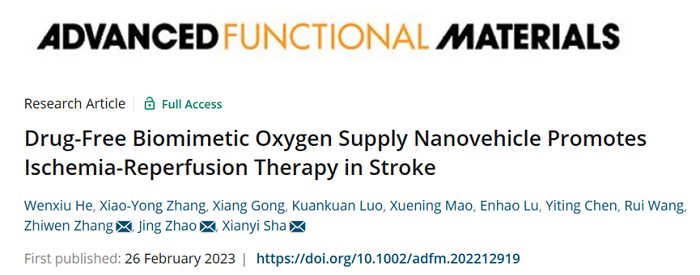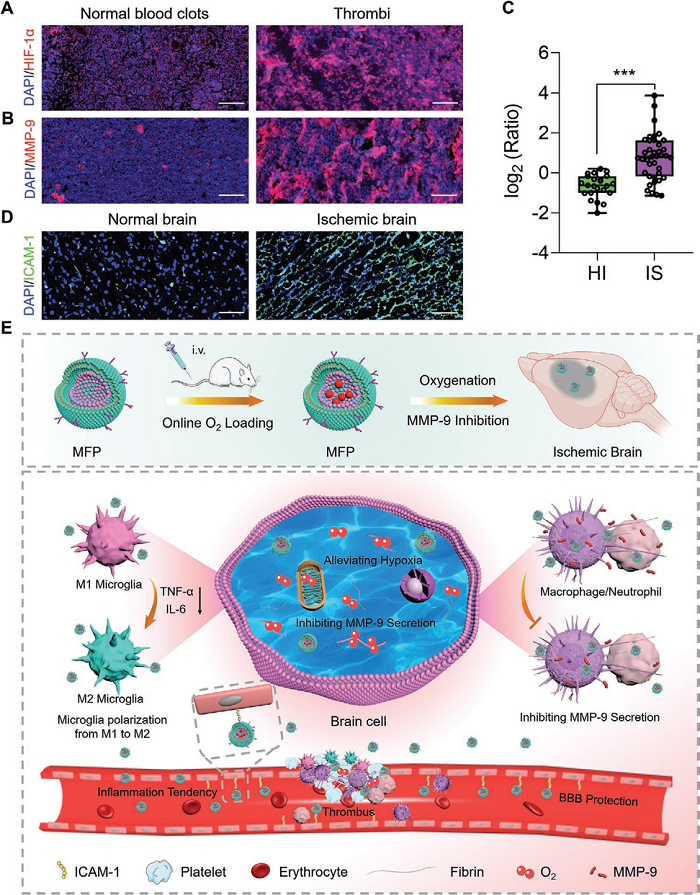
Ischemic stroke is a formidable disease with high morbidity, disability and fatality, which seriously threatens the life quality and health of patients. The clinically recommended treatment for ischemic stroke is intravenous thrombolysis or intra-arterial thrombectomy to timely restore the blood supply. Nevertheless, the brain is extremely vulnerable to oxygen-glucose deprivation due to its high metabolic activity and low carbohydrate storage, resulting in a very narrow time window for ischemia-reperfusion therapy. Recanalization beyond the treatment window increases the risks of cerebral hemorrhage and lead to reperfusion injury. So far, there is no effective method to prolong the time window of ischemia-reperfusion therapy, which remains the biggest obstacle for ischemic stroke treatment.

A team led by Professor Xianyi Sha from School of Pharmacy, Fudan University, and Professor Jing Zhao from Minhang Hospital, Fudan University, have reported a drug-free biomimetic oxygen supply nanovehicle for promoting ischemia-reperfusion therapy in stroke. In previous studies, they found that the hypoxia inducible factor-1 (HIF-α), a marker for hypoxia, and MMP-9, a marker for BBB damage, were highly expressed in thrombi of ischemic stroke patients (Fig. 1A, B). They synthesized a perfluoroundecane-derived amphiphilic polyfluorocarbon (PEG-SMA-F11) with an exceeding ischemia-oxygenation capacity. Additionally, they found that Pluronic P123 (P123), an amphiphilic block copolymer with excellent biocompatibility, was uniquely characterized in downregulating MMP-9. Based on the above research, they fabricated a drug-free biomimetic nanovehicle (MFP), in which the nanovehicle (FP) composed of PEG-SMA-F11 and P123 was camouflaged with M2 microglia membranes. MFP could load oxygen in vivo and preferentially access cerebral ischemic lesions in an inflammation-directed manner after intravenous injection. Subsequently, MFP elicited brain protection efficacy via enhancing oxygen and suppressing MMP-9 secretion in ischemic regions, conferring robust ischemic tolerance and reperfusion resistance of brain tissues for ischemia-reperfusion therapy (Fig. 1E).

Fig. 1. Schematic illustration of the drug-free biomimetic nanovehicle for ischemic stroke therapy.
The in vivo results based on transient middle cerebral artery occlusion (tMCAO) rat models have confirmed that, by utilizing the high affinity between the M2 microglia cell membrane and inflammatory vascular endothelial cells, MFP could efficiently cross the blood-brain barrier (BBB) and enter the ischemic brain parenchyma. By alleviating hypoxia and inhibiting MMP-9, MFP could effectively protect the integrity of the BBB and inhibit inflammatory response. Cerebral infarcts decreased from 36.66% in the control group to 11.03% in the MFP group, and the neurological functions of tMCAO rats was also effectively improved after MFP treatment. The Magnetic Resonance Imaging results showed MFP significantly reduced the infarct regions and delayed the infarct progression. The T2 values of ischemic brain was obviously decreased while the ADC values was evidently increased after MFP treatment. In addition, MFP effectively reduced the “no-reflow” of microvasculature induced by reperfusion injury. More importantly, MFP could effectively prolong the time window of ischemia-reperfusion therapy in tMCAO rats, and was also beneficial for mice with permanent ischemic stroke induced by photothrombosis. For ischemic stroke patients, time is brain. This study is expected to contribute to the clinical recanalization treatment for ischemic stroke patients, and can also serve as an adjunctive therapy for patients who are not suitable for recanalization therapy.
This work was published in Advanced Functional Materials entitled “Drug-Free Biomimetic Oxygen Supply Nanovehicle Promotes Ischemia-Reperfusion Therapy in Stroke”. The co-corresponding authors of this paper are Professor Xianyi Sha from School of Pharmacy, Fudan University, Professor Jing Zhao from Minhang Hospital, Fudan University, and Professor Zhiwen Zhang from School of Pharmacy, Fudan University. The co-first authors of this paper are Dr. Wenxiu He from School of Pharmacy, Fudan University, and Professor Xiao-Yong Zhang from Institute of Science and Technology for Brain-Inspired Intelligence, Fudan University, Key Laboratory of Computational Neuroscience and Brain-Inspired Intelligence (Fudan University), Ministry of Education. This work was supported by the National Key R&D Program of the Ministry of Science and Technology (2022YFC2304303) and the National Nature Science Foundation of China (81973157 and 82173646).
Link to original article:
https://onlinelibrary.wiley.com/doi/10.1002/adfm.202212919